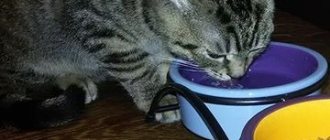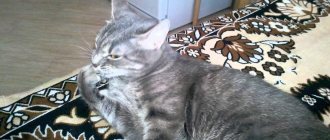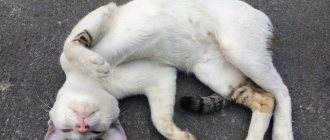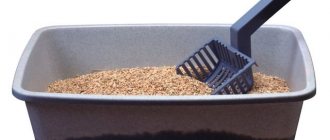If a bone or other foreign object is stuck in a cat's throat, the condition is accompanied by severe coughing, drooling, and the inability to swallow food. The owner must be able to recognize when the animal is reflexively coughing up grass or fur, and if the condition is dangerous and first aid should be provided to the pet. And also know when it is necessary to urgently contact a veterinary clinic.
Veterinarians categorically do not recommend giving your pet meat with bones, since bone fragments are the main reason why a cat chokes and can die.
Symptoms: how can you tell if your cat is choking?
The grass for a cat is a means of cleansing the stomach if hair has accumulated there. The animal eats plants on purpose so that they can tear them out later. Therefore, such vomiting is not considered a signal that the animal is choking. Most often, the cause is hard bone, large cartilage, or fragments of plastic toys that the cat has chewed. The kitten is choking on milk or water. If a cat has a bone stuck in its throat, the symptoms are as follows:
- anxiety and restlessness;
- profuse drooling;
- increased regurgitation;
- constant presence of the paw in the mouth, as if something was bothering him;
- refusal of food and water;
- strong tongue protrusion;
- wheezing or heavy breathing;
- the appearance of bloody impurities in the saliva if a foreign body is stuck in the esophagus.
Why cats can have big bones
Unlike other animals, in their oral cavity there is a special hyoid bone, which allows them to fix the tongue, muscles of the oral cavity or larynx. The mucous membranes are insensitive to fish bones, so a cat can confidently chew a bone even from a fish without injuring the mucous membranes, although it is better not to give them large and hard bones, especially a fish spine or tail.
© shutterstock
If part of the food or bone gets stuck in the throat, then the cat did not have time to chew the food thoroughly. In the wild, cats hunt birds and mice, whose bones can be small and sharp, but their powerful jaws and powerful teeth allow them to eat even feathers and bird claws without choking on them.
If a bone is stuck in the throat, it is often due to the following reasons:
- Acute hunger. If a cat has not been fed for a long time, it begins to immediately swallow food, without even noticing that there is a bone in it. By swallowing large pieces, the cat may choke and swallow the undigested item, so this can be very dangerous;
- If the animal stole fish scraps, bones intended for the dog. If dogs do not choke even on large fish bones, although they do not really like fish, then such food is contraindicated for a cat;
- If the owner gave the cat a whole fish or bones along with other parts. A well-cooked product may cause your cat to grab large pieces and choke on them;
- If she found fish waste on the street and began to gnaw on it.
The most dangerous for cats are duck bones, bones from large and fatty fish, especially silver carp, chebak, bream, pike, bones located closer to the head or tail. It is dangerous for cats to chew on the heads of large fish, since this is where bones are located that can get stuck in the mouth or throat. If a fish bone is stuck in a cat's neck, the owner will notice it. In such a situation, she may refuse to eat, try to independently remove a foreign object, or begin to meow pitifully. If this happens, take immediate action.
First aid
In such a situation, you can tap the animal on the back, tilting it down.
A kitten that has choked on milk can be lightly tapped between the shoulder blades, tilting it slightly. If your cat chokes on a fish bone, you can try to remove it yourself. Algorithm of actions:
- Wrap the cat in a thick blanket so that the paws are firmly secured.
- Examine the pharynx with a flashlight.
- Using a syringe without a needle, pour in a little vegetable oil to make the foreign body more pliable for removal.
- Use tweezers to carefully remove the bone.
If it was not possible to remove the bone, you can use this method:
- Kneel down, fixing the cat between your legs with your head away from you.
- Use sharp movements to squeeze the sides 4-5 times, making sure that the impact on the ribs is not too strong, otherwise you can break the bones.
- Cats cough and cough up foreign objects.
How to do artificial respiration?
ID is done on the pet when it is laid on its side.
If a cat has swallowed a bone and is choking, you should immediately call a veterinary ambulance and begin artificial respiration as follows:
- Place the animal on its side.
- With sharp movements, squeeze the chest 5-6 times towards the neck.
- Exhale 1 p. in the cat's nose.
- Continue massage of the sternum (80-120 r/min.).
- Alternate exhaling into the nose and massaging: 15 seconds. massage/exhalation 10 times.
Veterinarians prohibit giving a cat laxatives, disinfecting the throat with alcohol, or using force when opening the mouth, this leads to a burn of the mucous membrane or dislocation of the jaw.
Nuances to consider
Unfortunately, not every person who does not have a medical education and certain training is capable of providing emergency care. It’s even worse when a panicking owner, trying to help the pet, makes mistake after mistake, not giving it the opportunity to get out. What should you pay attention to if such a situation arises? First of all this:
- It is not recommended to remove a sharp bone located deep in the throat on your own unless the cat has lost consciousness. This can lead to damage to mucous tissues and subsequent suppuration.
- If the animal's efforts to get rid of the bone lead to vomiting, then most likely the object will come out along with the vomit. You shouldn’t interfere with your pet’s “getting rid of the excess.”
- When time passes, and the problem with the bone is not solved and the owner is unable to help the animal, you need to seek advice from a veterinarian. It will not be difficult for a specialist to assess the cat’s condition, determine the cause of the deterioration of the condition and remove the foreign body.
- Sometimes it is impossible to provoke vomiting in animals, for example, if he has swallowed a chemical substance.
- If your pet’s life is not in danger, then you can help get rid of the bone in a simple way by pouring 2-3 tablespoons of vegetable oil into its mouth.
The tissues of the larynx in animals are quite sensitive and can be seriously injured if sharp objects penetrate deeply.
The veterinarian will remove the bone as carefully as possible, using painkillers and disinfectants if necessary.
Also watch the video on what to do if your cat chokes on a bone or other food:
When do you need to see a doctor?
If your cat has a bone stuck in its throat, veterinary help is needed for the following symptoms:
A pet's fainting condition requires immediate doctor intervention.
- eye rolling;
- shortness of breath or lack thereof;
- loss of consciousness;
- bleeding from the mouth;
- cyanosis of mucous membranes;
- the foreign object cannot be pulled out.
The veterinarian will prescribe intensive care or surgery to remove the foreign body. When a cat has choked on a fish bone and it has been removed, consultation with a veterinarian is also required. A foreign body can injure the structures of the pharynx and esophagus, causing secondary infection and abscess formation. To prevent complications, your veterinarian will recommend drug therapy.
False symptoms
If a cat has dyspnea (feeling of lack of air), it is recommended to examine its mucous membranes. With hypoxia, that is, lack of oxygen, it acquires a rich red tint or becomes bluish. With obvious symptoms of suffocation, the pet can quickly die if emergency assistance is not provided.
But in some situations, a prolonged, obsessive cough that causes gagging has nothing to do with foreign objects in the respiratory tract. These may be other conditions:
- The cat swallowed fur - his behavior makes it seem like he is choking. A little later, you will notice how he regurgitates hairballs, as a result of which the signs of the disorder disappear.
- “False suffocation” - experiencing severe hunger, the cat inhales air so forcefully that its larynx is pulled into the soft palate. In this state, it is advisable to give him food, drink or stroke his chin.
If anxiety does not disappear after such events, and the cat refuses food, then it needs urgent help.
How to remove a bone from a cat's throat at home.
Many owners try to remove a stuck bone from a cat's throat on their own. If the animal does not show aggression, you can try to do this at home.
The first thing the owner does is try to feed the animal with bread crumbs or soft food. If after this the bone still bothers your pet, you can try to remove it with tweezers. This requires the participation of at least two people.
One should fix the cat's head and open its mouth. Many domestic cats allow their owners to do this. The second participant in the process must shine a flashlight into the pet’s throat and carefully examine it.
If the bone is clearly visible and accessible, you can remove it using tweezers. This must be done very carefully and hold your head tightly. If the animal tries to escape at this moment, the mucous membrane of the throat can be damaged.
Why do cats accumulate fur in their stomach?
The act of licking among felines serves as a demonstration of tender feelings and care. Everyone knows that a cat's tongue is hard and rough like a grater. This property is given to it by the smallest hook-shaped papillae, which completely cover its surface.
The cat's tongue, in addition to its main functions, plays a major role in hygiene procedures: it serves as a comb, brush, and a means of moisturizing and deodorizing the fur. It is the tongue that allows the animal to maintain its coat in perfect condition. During licking, fallen hairs and undercoat fluff, particles of dirt and sebum cling to the papillae, and the cat simply spits them out. However, a small amount of fur is still swallowed and ends up in the stomach.
The cat's stomach is not equipped to digest wool and hair, and they leave the body naturally along with digested food - with feces.
Sometimes the wool swallowed during licking is retained in the stomach and forms trichobezoars - clusters, lumps of wool.
Interesting! Trichobezoar means “hair stone”.
To remove them from the cat’s body, nature has provided another way: belching. From time to time, the cat gets rid of stomach discomfort and regurgitates fur. This phenomenon is normal, it happens up to 2 times a week. Long-haired cat breeds regurgitate hair more often than smooth-haired cats.
Trichobezoars have the shape of a cylinder or small oval lumps. This unusual appearance is due to the fact that they have to travel through a narrow esophagus. Often the release of a hairball is accompanied by the release of mucus and food debris. There is nothing wrong with this, on the contrary: the stomach cleansed itself.
This method of self-purification is provided by nature. The mechanism is triggered when the cat feels that its stomach is full. Even small kittens who have barely learned to lick their fur will be able to regurgitate their fur in time.
However, there are often cases when swallowed fur for some reason did not have time to leave the cat’s body naturally in time. It accumulates in the animal’s stomach into dense large lumps and becomes a threat to its health.
Causes of non-evacuable trichobezoars:
- too intense shedding - almost all “apartment” cats suffer from this;
- hair loss, which is associated with diseases, stress, lack of vitamins;
- age and excess weight – this causes decreased gastric motility;
- infestation with worms - makes the cat lick itself more often than usual.
How much does it cost to remove a bone from a cat's throat?
As a rule, this service in clinics is called something like this: “Removal of a foreign body from the pharynx, oral cavity, mouth.”
In Moscow, prices range from 500 to 1500 rubles. You may need to add the cost of the appointment to this, but this needs to be clarified with the chosen clinic.
Addresses of clinics in Moscow providing these services can be viewed at the link: https://zoon.ru/msk/m/izvlechenie_inorodnogo_tela_u_zhivotnogo/
We found information on the website of the Kursk clinic - price from 1100 rubles.
You need to call and check with each specific clinic.
This procedure may cost differently. The cost depends on the complexity of the operation. The price may be affected by the size of the animal, which affects the amount of anesthesia. Veterinary clinics often have a price list that indicates the average cost of such a service. However, it all depends on the specific case.
Useful tips
Recommendations from specialists will help facilitate the examination of the animal, provide it with more qualified assistance in a critical situation and save a choking cat :
- When examining the mouth, use a flashlight, this will make it possible to quickly detect a foreign object.
- A pet can bite even if it is almost unconscious, so you should be careful.
- A choking cat may die from asphyxia. What the outcome of the incident will be largely depends on the speed of reaction of the pet’s owners.
When calling for help, the veterinarian may administer anesthesia to make it easier to examine the animal and get a good look at the foreign body in the mouth. In some cases, an x-ray, the use of an oxygen mask, and immobilization of the cat are necessary.










